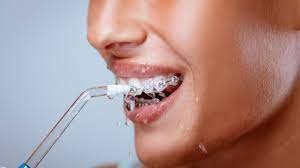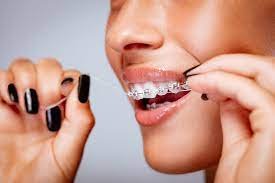How to Floss with Braces: 4 Different Ways
Flossing your teeth is essential to maintaining good oral health. How to floss while wearing braces is even more critical because it reduces the chances of getting gum diseases and cavities. After meals, food particles tend to remain between your teeth and the braces. Getting rid of all the food particles can be tricky. Flossing is necessary to remove plaque and the particles between your teeth and from the surfaces of your teeth efficiently. Many people with braces find it hard to floss their teeth, and the big question here is, how to floss with braces. Never get worried about how to floss with braces; it is possible.
Below are some of the different ways to floss with braces.
Traditional Flossing
Traditional flossing works by moving thin filaments of strings to eliminate plaque in your teeth when flossing with braces. String floss is either waxed or non-waxed. Waxed string floss is easy to use because it can pass through the interdental spaces without much effort. It comes in different sizes and colors. String flossing is a manual method, effectively removing all food debris on your teeth’s surface.
Pros of Traditional Flossing
It is an efficient method for removing food debris from any face of the teeth.
You can take standard string floss with you anywhere, anytime, if you need to floss your teeth.
Cons of Traditional Flossing
The method involves moving the floss filament manually, which can cause gum bleeding if you are not keen.
Traditional dental floss disturbs your gum, and this might make your gum swell with time.
String floss might end up tempering with the braces, potentially damaging them.
Floss Threader
Using a floss threader requires you to insert a piece of floss in the threader, then insert the threader between your teeth above your braces. Then, after every interdental space, pull the floss and repeat this process.
Pros of a Floss Threader
A piece of floss is designed in nylon, making it last longer and reusable.
A floss threader is cheap and accessible on most online shopping sites and pharmacies around you.
Threading the floss doesn’t require much knowledge, and almost anyone can practice the method.
Cons of a Floss Threader
Flossing with a threader is time-consuming. The whole process might take 10-15 minutes.
The method is trickier to learn due to its complicated nature. In addition, one might find it harder to pass the floss through the threader.
Water flosser
A water flosser works effectively by shooting a thin stream of water at your teeth. It aims at the teeth to eliminate food debris and plaque. The water flosser will help you reach hard-to-reach areas without using traditional floss. Braces are not a limiting factor in flossing; flossing with braces just requires a little creativity.
Pros of Water Flossers
A water flosser involves minimal manual movement. The machine does most of the work for you, unlike other methods.
There is no risk of gum bleeding because the floss thread is not involved.
Cons of Water Flossers
They are costly compared to the other flossing tools.
The water jets are less effective at removing plaque than the other flossing methods.
Dental Tape
Dental tape is nylon waxed floss tape for easy penetration between the teeth and the braces. To use it, you push the tape in the spaces between your teeth and the braces to remove plaque. Dental tape is wider and flatter than traditional floss.
Pros of Dental Tape
It is broader in size compared to standard floss. This feature makes it the most efficient as it removes all substances between your teeth compared to standard floss. A dental tape covers more surface area in the interdental spaces and cleans between teeth, making it more efficient.
Cheap and long-lasting- dental tape of a polyethylene material has a high tensile strength making it less likely to wear out or break when flossing with braces.
Cons of Dental Tape
It can cause bleeding gums in some cases.
The high tensile strength can detach the brackets from the wires when flossing with braces.
Is flossing with braces necessary? What happens if you don’t floss with braces?
It is essential to floss with braces. Braces significantly increase the risk of gum disease like gingivitis. Flossing with braces helps remove food residues even after brushing your teeth. Flossing improves your oral health and reduces the chances of being infected with oral-related diseases. Trapped food residues create an environment for bacteria growth, leading to cavities or even tooth decay. In general, provided you have braces and you want to maintain oral hygiene, flossing is essential. You have to adapt to how to floss with braces with the available flossing tools.
Why is Flossing with Braces Hard?
Braces make flossing more challenging and more time-consuming compared to brace-less teeth. Braces create more of a challenge by creating a barrier at the surface of the teeth. In addition, the arch-wire limits the floss from accessing any food particles, residues, and plaque buildup between the teeth. Eliminate food remains, or bacteria breeding may occur, and you will start experiencing gum-related diseases. If you value a better smile with the braces, floss regularly.
What is the easiest way to floss with braces?
Using Water Flossers is the simplest way to floss with braces because it involves the least manual work.
Conclusion
Oral hygiene is necessary for your daily life. Whether you have braces or not, flossing your teeth should be a priority and done daily. When flossing with braces, ensure you don’t tamper with the brackets and wires. Try your best using the available flossing tools for those who find it hard to floss with braces. Always feel free to go over flossing methods with your orthodontist.
Ask an Orthodontist – FAQ
-
Yes! Everyone should floss, especially with braces; you will have a healthier smile.
-
Braces or not, you should floss daily. Make sure that you floss at least once a day.
-
It will help if you floss first, then brush your teeth with fluoride toothpaste to eliminate all residues and debris in the gum line. Provided you have braces, floss, and brush your teeth daily.
-
It is never too late since there is no dental age limit for someone to start flossing, but the earlier, the better.
Orthodontic Arts, your number one Orthodontist in OKC. Our Certified Orthodontist provides the latest and greatest Orthodontic practices to our clients in the OKC and Midtown area. Orthodontic Arts is the best place for child and teen orthodontics as well as adult orthodontics. Be sure to ask about Invisalign and invisible braces! Contact us today at (405) 604-3745 or request an appointment.



